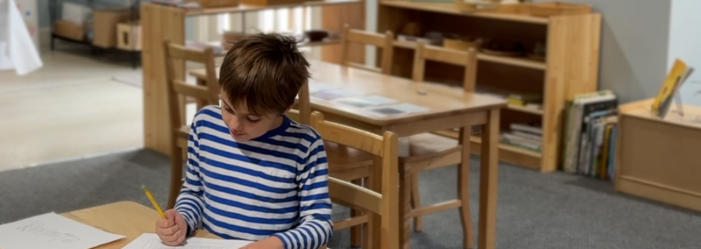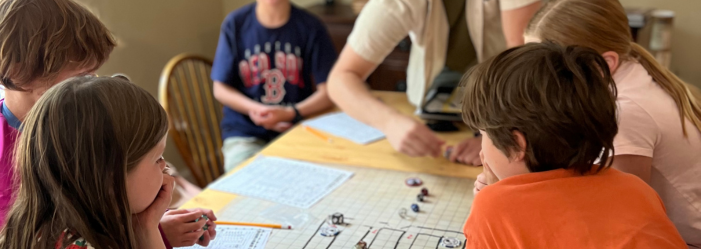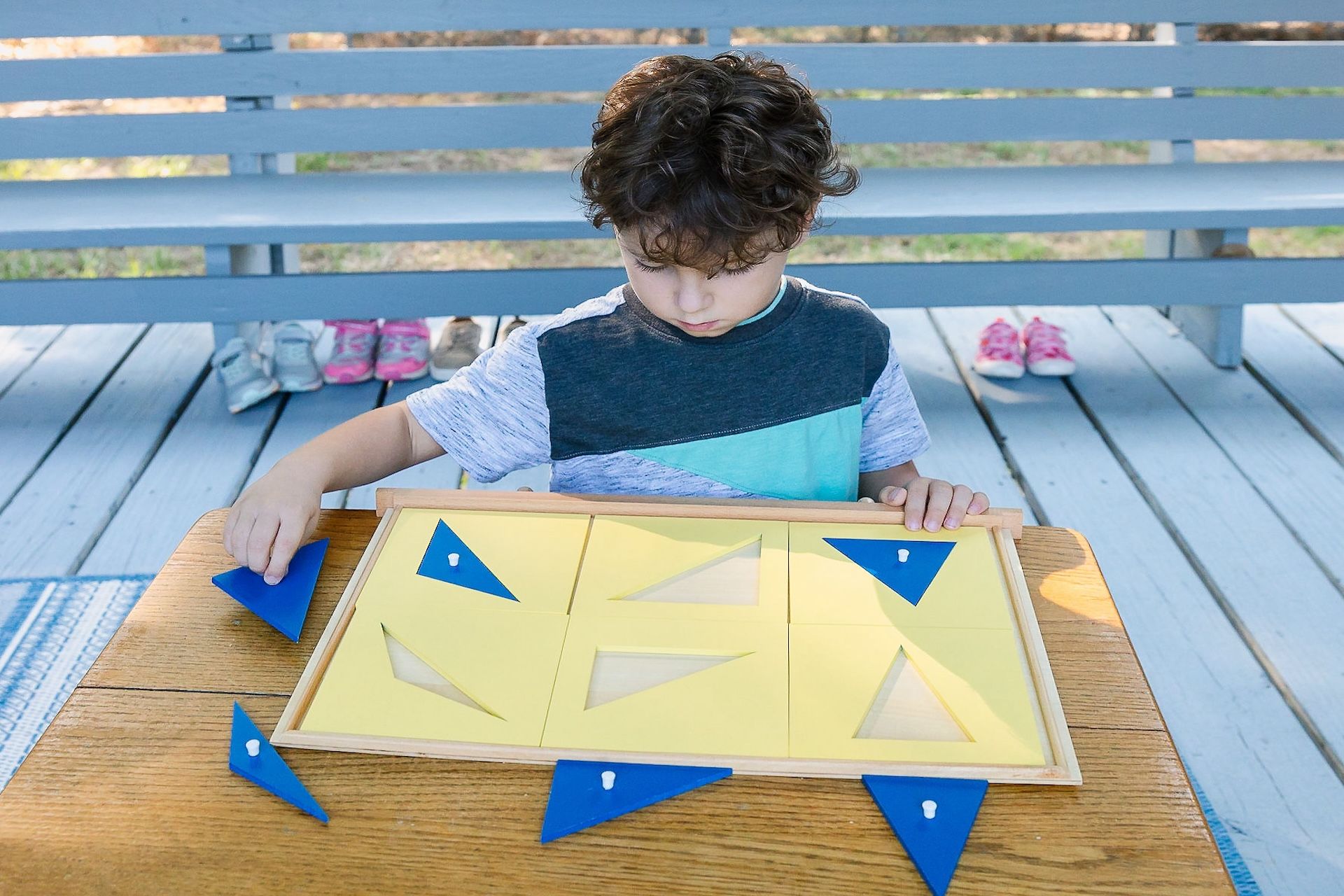Montessori Time Management for Kids: Growing Calm, Confident, and Capable Learners
Montessori Time Management for Kids

Every parent knows the morning rush: reminders to brush teeth, finish breakfast, find shoes, and somehow get out the door on time. Time can feel like the enemy, but for children, time is still an abstract concept, something they must learn to see and feel through experience.
That’s where Montessori time management for kids comes in. Instead of relying on adults to dictate every minute, children learn to manage their own time through structure, independence, and gentle guidance. The goal isn’t to create tiny clock-watchers, it’s to nurture responsibility, awareness, and calm within daily routines.
At Sandwich Montessori School, we see time as part of the child’s prepared environment, something to explore, not control. Moving at their own rhythm, children learn balance, focus, and respect for the pace of life.
Dr. Maria Montessori once wrote:
“Never help a child with a task at which he feels he can succeed.”
That same idea applies to time. When children are trusted to manage it, they rise to meet that trust. Just as a tree grows stronger by standing in the wind, children grow braver and more capable when they’re trusted to manage their own moments.
Why Time Management Matters for Kids
Time management is a lifelong skill, and in childhood it’s about much more than sticking to a schedule. It helps children:
- Develop independence: learning to start and finish tasks on their own.
- Build focus and concentration: understanding how long activities take.
- Practice self-discipline: noticing when to begin, pause, or move on.
- Gain confidence: experiencing the satisfaction of completing something without reminders.
When children learn to manage time in small, consistent ways, they begin to take ownership of their learning, and their day. This sense of ownership grows into a quiet pride, the same calm confidence we nurture in every child at Sandwich Montessori School.
Children who understand how to manage time don’t just move through routines more smoothly, they develop an internal sense of order, agency, and the ability to regulate their actions. They start to see themselves as capable of organizing their world, not simply following adult direction.
In childhood, this is the foundation of executive function, the set of cognitive skills that includes planning, prioritizing, staying focused, and following through. These abilities don’t appear all at once; they’re built gradually through everyday experiences that allow children to practice making decisions, adjusting, and noticing patterns.
In Montessori environments, these skills grow naturally through hands-on work, observation, and freedom within limits. Children practice pacing themselves, organizing their space, and respecting others’ time as they grow habits that translate beautifully to life beyond the classroom.
When a child learns to notice that they have ten minutes left to finish a puzzle, plan that story time comes after snack, or recognize that they can start getting ready before being asked, they’re actually rehearsing the same mental skills that adults use to manage projects, meet deadlines, and balance responsibilities later in life.
There’s also an emotional layer here. Children who can pace themselves begin to experience what psychologists call
self-efficacy, the belief that “I can handle this.” Each small success (“I remembered my water bottle,” “I finished before the timer!”) reinforces confidence and reduces dependence on external reminders or rewards.
It’s not about rigid schedules or perfect punctuality, it’s about helping children feel in balance with their day. When time has structure, it brings calm. When that structure comes from within the child, it brings confidence.
At Sandwich Montessori School, we help children discover that calm doesn’t come from control, but from connection, with themselves, with their environment, and with the natural rhythm of the day.
Practical Ways to Teach Time Management
You don’t need elaborate systems or apps to teach children how to manage time. Simple, tactile tools, many inspired by Montessori classrooms, are often the most effective.
1. Use Visual Schedules
Visual schedules are a bridge between abstract time and concrete understanding. Post a simple chart showing the order of daily routines, morning, school, play, dinner, bedtime. Use pictures for younger children and words for older ones.
Let your child help design it, choosing the order or drawing the icons. This shared planning moment strengthens connection and gives your child a voice, essential ingredients in growing confident decision-makers.
2. Introduce Timers
Timers turn time into something children can see and hear:
- A sand timer for brushing teeth or cleaning up.
- A visual countdown timer for reading or getting ready.
- A gentle bell for transitions between activities.
When a child sees time passing, they begin to feel the rhythm of it, an early form of self-regulation. Sand timers, hourglasses, or even watching the sunlight shift through the day connect children with natural rhythms, helping them sense time the way nature does, through pattern and flow.
3. Practice Reflection
At the end of the day or week, take a few minutes to talk about how things went. Ask:
- “Which part of the morning felt rushed?”
- “What helped you remember your backpack today?”
- “What could we change tomorrow to make it easier?”
This self-reflection is a quiet but powerful way to build awareness. Children begin to see time not as something done to them, but as something they can manage. When children reflect, they also learn courage, the courage to notice, adjust, and try again.
Creating a Supportive Environment
Children thrive when the environment supports their independence. Small adjustments can make a big difference:
- Keep clocks visible in shared spaces.
- Use baskets or labeled trays for daily materials so children can find what they need quickly.
- Create a predictable routine for mornings and evenings, consistency builds confidence.
The goal isn’t to fill every moment, but to give children a sense of stability so they can use their time purposefully. A well-prepared environment is the child’s silent teacher. At Sandwich Montessori School, we design our classrooms, and encourage families to design their homes to invite calm flow, not rush.
Age and Readiness
Understanding time isn’t something that clicks overnight, it unfolds slowly, just like reading or tying shoes. Each age brings new awareness and opportunities to build time management skills in ways that feel natural, not forced.
Here’s how this might look:
Infants and Toddlers (Under 3): Building Trust Through Rhythm
For infants and toddlers, time isn’t something they can measure, it’s something they feel. The way we move through the day with them teaches rhythm, consistency, and trust long before clocks or routines make sense.
At this age, Montessori time awareness is about helping the youngest children feel safe in the predictability of their world. When life follows a gentle rhythm: waking, feeding, playing, resting...children begin to internalize a sense of order that lays the foundation for all future independence.
You might try:
- Keeping a consistent daily rhythm, even if exact times vary.
- Naming transitions softly: “Now it’s time to change your diaper,” or “After your nap, we’ll go outside.”
- Moving slowly and predictably and giving your child time to process what’s happening next.
- Offering the same songs or gestures during transitions, like a short tune before meals or a simple phrase before bed.
These patterns help children feel secure and respected. When the world is predictable, they relax into it, and that calm trust becomes the starting point for self-regulation and independence later on.
As Dr. Montessori observed, even the youngest child “absorbs the order of the environment.” Through daily rhythms filled with kindness and presence, we’re already teaching the foundation of time management: patience, awareness, and trust in the flow of the day.
Ages 3–5: Learning Sequencing and Routine
For preschoolers, time is experienced as “what happens next.” They don’t grasp minutes or hours yet, but they can feel the rhythm of routines. This stage is all about sequencing and consistency, helping children predict what comes next so their day feels safe and orderly.
You might try:
- Narrating routines aloud: “First we get dressed, then we eat breakfast, then we brush teeth.”
- Using picture schedules or cards that show each step in the morning or bedtime routine.
- Singing cleanup or transition songs (“When we’re done with playtime, we put toys away”).
- Offering gentle countdowns: “Five more minutes until it’s time to clean up.”
At this age, predictability builds trust and confidence. When children can anticipate what’s next, they feel secure, and that emotional security becomes the foundation for independence later on. This trust is the first root of self-discipline, what Dr. Montessori called normalization–when inner order mirrors outer order.
Ages 6–9: Building Awareness Through Planning and Observation
Children in the elementary years begin to understand the flow of time more concretely. They can estimate short durations (“This took me ten minutes”) and start planning their day in simple blocks. This is the perfect stage to introduce visual timers, clocks, and self-paced tasks that make time tangible.
Try these:
- Visual timers for independent work: Let your child see how long they want to read or clean up, and allow them to reset the timer themselves.
- Daily checklists: Use a simple notepad or whiteboard where they can write, or draw, the day’s priorities.
- Short planning sessions: Each morning or evening, ask: “What do you want to finish before dinner?” or “How long do you think that will take?”
- Reflection moments: After an activity, talk about whether their time estimate felt right. (“Did fifteen minutes feel long or short for you?”)
This helps children connect how they spend time with how it feels. They begin to see that time isn’t something happening to them, it’s something they can manage thoughtfully. At this stage, bravery blooms and children start to trust their own sense of pace and capability.
Ages 10–12: Strengthening Independence and Self-Evaluation
During the upper elementary years, children can plan projects, set goals, and monitor their own progress. They’re developing stronger executive function and are ready to manage larger stretches of time with increasing independence.
Here, the focus shifts to goal-setting, accountability, and reflection.
You can encourage this by:
- Weekly goal-setting: Ask, “What’s one thing you’d like to finish this week?” and help them break it into smaller steps.
- Time estimation games: Before starting homework or a chore, have them guess how long it will take, then check afterward.
- Responsibility anchors: Encourage them to set their own morning alarm, track a reading goal, or manage a weekly calendar of activities.
- Self-reflection journals:
Invite them to write or talk about what helped them stay on track, or what they’d like to adjust next time.
The goal is never perfection, it’s awareness. When children learn to recognize how they use their time, and what helps them stay focused, they’re developing habits that will serve them for life. At Sandwich Montessori School, we remind families that the goal is not control, but growth of independence, awareness, and self-trust.
Meeting Each Child Where They Are
Children progress at their own pace, and that’s okay. The goal isn’t to create a perfectly timed schedule, but to help each child grow a healthy relationship with time built on rhythm, responsibility, and trust.
Your role is to provide the structure and tools, then step back just enough for them to practice. Over time, they’ll discover that time management isn’t about control, it’s about freedom.
When children can manage their own time, they don’t just get more done, they gain the confidence to direct their own learning and life. They begin to move through their days with the same grace we see in nature: steady, purposeful, and beautifully balanced.
The right approach meets each child where they are while guiding them toward self-management without pressure or perfection.
The Big Picture
When children learn to manage their time, they aren’t just staying on task, they’re learning self-awareness, responsibility, and respect for their own rhythm of work and rest.
At home, these small lessons ripple outward. Morning routines become calmer, transitions smoother, and children begin to take quiet pride in using their time well.
“The greatest gifts we can give our children are the roots of responsibility and the
wings of independence.” — Maria Montessori
At Sandwich Montessori School, we nurture those roots and wings daily, helping children grow kinder, braver, and stronger as they learn to manage themselves and their moments.
Looking for More?
At Sandwich Montessori School, we help children develop independence and responsibility, one moment at a time. Every routine is an opportunity for growth.
Discover how Montessori time management helps children find calm, confidence, and connection in each part of their day.
Learn more about our
Elementary Program,
Middle School Program, or
Homeschool Programs.













